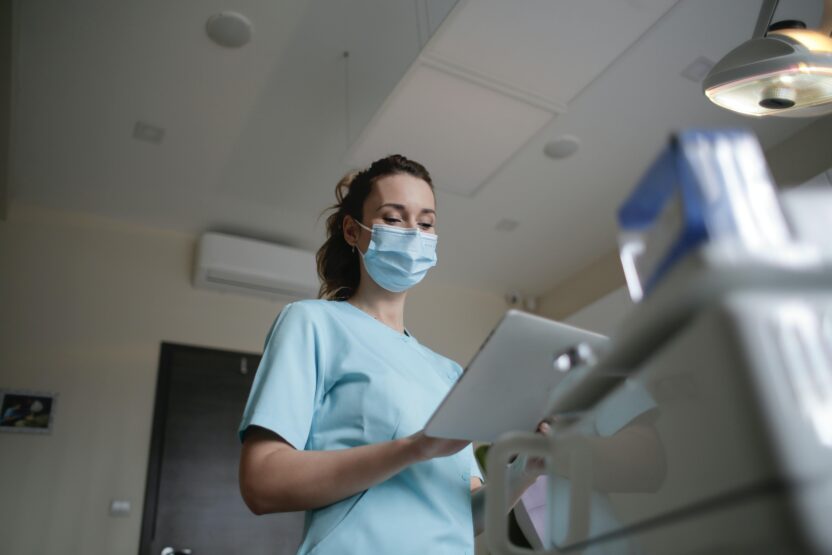NHS publishes new 'Specialised Ventilation for Healthcare Premises' Technical Guidance for NHS with support from Archus

The technical advisory team at Archus has announced the publication of new NHS Technical Guidance for ‘Specialised Ventilation for Healthcare Premises’. The announcement comes as part of our appointment by NHS England and NHS Improvement to provide a multi-year (2019-2023) programme of new and updated technical guidance.
Health Building Notes (HBNs) and Health Technical Memoranda (HTMs) have been published by central government for the NHS since 1961. These essential resources for the NHS and its supply chains define current best practice in the design and engineering of healthcare facilities – acute hospitals and primary and community premises.
The HBNs and HTMs enable consistent procurement of high-quality infrastructure for the NHS – improving clinical outcomes, efficiency and productivity. They focus on continuously improving healthcare built environment standards: helping to ensure patient and carer safety, privacy and dignity and better working conditions for NHS staff.
The NHS is a highly specialised environment with unique issues. Therefore, specific technical guidance and standards are needed by the NHS for its infrastructure.
The new specialised ventilation guidance is published in two parts:
Part A: The concept, design, specification, installation and acceptance testing of healthcare ventilation systems. This applies to new installations and major refurbishments of existing installations and should be considered as the standard to be achieved.
Part B: The management, operation, maintenance and routine testing of existing healthcare ventilation systems. This guidance applies to all ventilation systems installed in healthcare premises irrespective of the age of the installation and should be considered as the standard to be achieved.
The documents give comprehensive advice and guidance on the legal requirements, design implications, maintenance and operation of specialised ventilation in healthcare premises providing acute care.
As part of our Technical Advisory service offering, we have a dedicated team and supply chain delivering this prestigious multi-year commission from NHS England and NHS Improvement. We are pleased to be able to offer a combination of many years’ experience in production of the NHS technical guidance and procurement of appropriate specialists for each topic. To date, we have scoped 18 topics that are at various stages of production. We will be scoping a further tranche of topics in the coming months.
Chris Turner, Executive Director at Archus
The core principle of the Health Technical Memorandum (HTM) is that the default method of ventilation should as far as possible be natural ventilation followed by mixed mode (natural with mechanical ventilation), with mechanical ventilation being the last option.
Since the last edition in 2007, there have been many legislative changes aimed at reducing energy consumption and technical advances that have increased operational efficiency. This revised HTM incorporates those changes and has amended many of the design parameters for healthcare ventilation. Designs that are simply repeated from previous installations designed to superseded standards and guidance will not meet the revised energy or operational standards and will not produce a compliant result.
This HTM was prepared prior to the COVID-19 pandemic caused by the severe acute respiratory syndrome coronavirus 2 (SARS-CoV-2) and has been reviewed against the known transmission evidence available at the time of publication. Ventilation is one of many mitigations against the virus and should be part of a package of infection prevention and control measures. The ventilation rates recommended in this document are likely to provide a lower risk environment for COVID-19 airborne transmission. Emerging evidence will continue to be reviewed as and when available.
Health Technical Memorandum 03-01 (2021) supersedes all previous versions of Health Technical Memorandum 03-01 – ‘Specialised ventilation in healthcare premises’ (2007). It also supersedes HTM 2025 (1994) and DV4 (1983).
Key updates include:
HBN 14-02: Medicines storage in clinical areas
HBN 14-02 provides best practice guidance on storage facilities for medicines (including controlled drugs) in clinical areas. This guidance was first published as a standalone chapter in HBN 00-01 – ‘General design principles’ in 2012. When HBN 00-01 was revised in 2014, the chapter on medicines storage was removed to become an HBN its own right. It is largely related to acute hospitals, but the general principles are the same whatever the clinical setting. HBN 14-02:
• clarifies the legislative controls around medicines storage;
• provides new guidance on automated drug storage cupboards;
• clarifies storage temperatures and temperature monitoring;
• provides, in table format, a summary of major requirements for medicines storage for easy reference.
The guidance covers storage requirements for the following specific categories of medicines:
• controlled drugs;
• epidural infusions and other high-risk medicines (wards only);
• intrathecal chemotherapy;
• oral solid medicines;
• injectable medicines;
• injectable anti-cancer medicines;
• oral liquid medicines;
• medicines to take home;
• flammable medicines;
• medicines requiring refrigerated/ freezer storage;
• medicines administered rectally and external medicines and dressings;
• IV fluids;
• patients’ own medicines.
On the construction of medicines cupboards (except automated drug dispensing cupboards and those used for patients’ own medicines), the HBN recommends that all cupboards should be made of metal in order to be able to comply with BS 2881. However, existing installations that do not comply need not be replaced immediately, but rather when plans for upgrading are being prepared (unless patient or staff safety would otherwise be compromised).
HBN 15-02: Facilities for same day emergency care/ambulatory emergency care
Same day emergency care (SDEC) is the provision of patient care with an investigation and/or treatment within the same day for non-elective patients who in the past would otherwise be admitted to a hospital bed. This approach has improved clinical outcomes and patient experience, and reduced costs and pressures in the urgent care system.
This new HBN gives guidance on the planning and design of an SDEC department. It supports the current Long Term Plan’s ambitions for SDEC services. A well-designed SDEC unit will help to manage patients effectively with minimal delays as they move through stages of care. Good patient flow is central to patient experience, clinical safety and reducing the pressure on staff. It is a key factor in providing effective healthcare.
The technical guidance specifies the rooms/areas that should be considered when planning and designing an SDEC unit and also provides:
• a generic layout diagram (Appendix 1), which sets out an example arrangement of services expected in such a facility;
• schedules of accommodation (Appendix 2), which list all the rooms, following the patient through the SDEC, and gives the floor areas of each room.
• room data sheets (Appendix 3);
• an SDEC Activity Calculator, an aid to calculating room sizes based on projected annual attendances.
The schedules of accommodation spreadsheet and SDEC Activity Calculator can be downloaded as separate files.
The HBN describes:
• the patient pathway – the route an individual will take through the SDEC;
• the essential and desirable adjacencies – the prime links with other departments (for example, Emergency Department);
• the functional relationships with other departments (for example, diagnostic imaging).
The core recommendations of the technical guidance are:
• Where possible, the SDEC facility should be close to a type 1 Emergency Department.
• Patients should have access to diagnostics within the same time frame as other emergency patients as acuity and availability allows.
• The SDEC facility should have a combination of consulting rooms, patient trolleys and chairs for patient assessment and treatment.
• Beds should not be provided in an SDEC unit as it may have a negative impact on patient flow.
